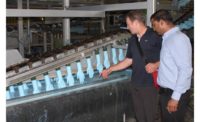Strict food safety standards guide and challenge meat and poultry product manufacturers amid an already competitive global marketplace. Now, growing demand for organic products free of chemical preservatives, diversifying demand for new and different flavors, and desires for conveniently packaged foods are creating new challenges for food manufacturers.
As meat manufacturers rethink their packaging operations to address these new hurdles, Paula Feldman, director, Business Intelligence at PMMI, The Association for Packaging and Processing Technologies shares important considerations to make before investing in new equipment.
Q. How has food safety standards changed for the meat and poultry sector?
P.F.: One of the most damaging events for a food producer is having to issue a recall. While the capital expense of having to pull products off of shelves is detrimental, untold damage is done to a brand’s image in the mind of the consumer when a producer has to issue a public declaration that a product is unsafe.
In order to avoid the stresses of a recall, food producers have turned to revised best practices and cleaning guidelines that assist in assuring their production processes are as sanitary as possible. These new standards have been presented for the meat and poultry industries by both the USDA through their Food Safety and Inspection Service (FSIS) and the FDA through the Food Safety Modernization Act (FSMA). Revised washdown techniques and categories, such as the IP69K rating, provide meat and poultry manufacturers with clear guidelines of how to properly sanitize their equipment.
Overall, the revised production standards laid out by both the USDA and FDA have resulted in a greater amount of oversight when it comes to meat and poultry. The USDA and FDA now work more closely than they ever have in the past to ensure that meat and poultry are safe for consumption.
Q. How has the demand for products that are free of chemical preservatives challenged meat and poultry manufacturers?
P.F.: Consumers increasingly demand food products that are all natural, with one of the key desires being meat and poultry that is free from artificial chemical preservatives. This has challenged meat and poultry producers to devise new methods of preservation and packaging that are natural and effective, yet still retain desirable visual properties in the meat.
There are a number of ways in which meat and poultry producers have achieved natural preservation. Some producers have turned to naturally derived alternatives to chemical preservatives, such as antimicrobial coatings, as a way to satisfy consumer demands. In addition to natural alternatives, meat and poultry producers have also innovated their production and packaging approaches to present their products in a visually appealing way while simultaneously extending shelf life. New processes such as high-pressure processing (HPP) and UV sterilization, coupled with creative packaging formats like modified atmosphere packaging (MAP), and vacuum packaging, have allowed meat and poultry producers to safely eliminate chemical preservatives.
Q. What are some ways meat manufacturers are rethinking their packaging operations?
P.F.: As consumer tastes evolve, meat and poultry producers have sought ways to differentiate their products and make them more attractive to consumers when placed on a shelf. One of the emerging trends in meat and poultry packaging is the expansion of sustainable and environmentally friendly materials. While other food industries have already made large strides in this category, the meat and poultry industries have only recently joined the bandwagon of “green” packaging.
Meat and poultry producers have also turned to flexible packaging as a way to make their products more appealing. Consumers have a desire to inspect their meats visually, so meat and poultry producers have expanded their offerings of modified atmosphere packaging (MAP) and vacuum packaging, which allows for meat to be presented in a visually appealing way. These packaging styles have presented additional challenges to producers however, as they must find film material capable of handling their specific requirements. Meat and poultry manufacturers are looking for sustainable films with less wrinkling, less trim waste, higher machine durability and a wider range of temperature resistances.
Q. What are some more sophisticated equipment and solutions that suppliers are offering meat and poultry manufacturers?
P.F.: One of the largest concerns for meat and poultry producers is sanitation. Advancements in the washdown process, such as the ingress protection (IP) rating system and machine componentry that can be fully sanitized without the need for bagging, enable manufacturers to explore production solutions that previously were not available to them. Specifically, new washdown techniques and stainless-steel designs have allowed meat and poultry producers to expand automated processes all the way down the line to carcass processing. Where previously wet processes were too messy to be automated, machines equipped with even advanced robotics can now be cleaned and sanitized effectively enough to utilize at the very front of a production line. By automating these early processes, meat and poultry manufacturers have been able to increase their production speeds while reducing the threat of injury to their employees.
Q. How else can companies evolve their production lines without sacrificing quality and efficiency?
P.F.: The future of production will be automation. As meat and poultry producers are tasked with producing increasing amounts of product under more stringent safety regulations, both physical and data automation will play a key role in helping manufacturers adapt. Physical processes like deboning and cutting can now be handled through automation, enabled by advances in sanitation and cleaning that allow these processes to be taken over by automated machines and robotics. Data automation will also enable meat and poultry producers to efficiently manage their incoming ingredients, production process, packaging process and distribution networks to eliminate waste and costly downtime.
Discover More at PACK EXPO Las Vegas
Meat manufacturers seeking industry insight for advancements in packaging will find solutions at PACK EXPO Las Vegas 2017 (Sept. 25–27; Las Vegas Convention Center). Meat and poultry professionals can browse the booths of hundreds of exhibitors to see innovations in HPP, MAP, robotics, automation, palletizing, primary and secondary packaging materials and containers up close and in action. Co-located with the PMMI-produced Healthcare Packaging EXPO, PACK EXPO Las Vegas will feature more than 2,000 exhibiting companies and 30,000 attendees, including 5,000 international visitors from more than 125 countries. Attendees should also take advantage of free and convenient educational presentations delivered at three Innovation Stage locations, addressing the challenges of clean label, food safety and line productivity as well as innovations in HPP, pouch packaging and food safe technology that can double the shelf life of organic foods without preservatives.
Learn more at www.PMMI.org, www.Packexpo.com and www.PMMIMediaGroup.com.




Report Abusive Comment